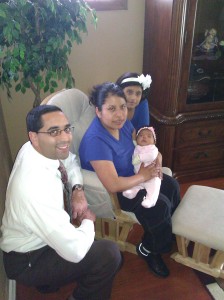Sustainable Prevention: At The Intersection of America’s Two Most Powerful Social Networks
Posted on | October 21, 2015 | 2 Comments
Mike Magee
Last week, I made a quick trip to Washington – one day, back and forth, from Hartford, CT. I was there to seek advice from an old friend as we complete planning for the second decade of the Rocking Chair Project. This early childhood intervention program targets young, economically disadvantaged, expectant mothers, supporting them with a physician-led home visit which includes the gift of a upholstered glider rocking chair and ottoman as a “gift of nurturing” for both mother and child. The visits, repeated over 1000 times in the past 10 years, include reinforcement of health messages and an emphasis on long term continuity with the health care system.
The challenge now is scaling up what we know to be a low-cost, highly impactful intervention. We have been relying on individual 2nd year Family Medicine residents around the country to identify the target moms, and to follow through with these “high-touch” visits. It has worked, but requires a fair amount of hands-on coordination and is not easily scalable.
Our lead adviser, Yale Professor Emeritus, Ed Zigler (Father of Head Start), told us a long time ago that the intervention was so low cost and powerful, tapping into two critical social networks (Medicine and Family), that it should be offered to entire populations, not just a lucky few individual patients.
My DC friend summed up the challenge immediately. He said we were seeking “a vertically integrated network with existing distribution channels”. Translation, a well organized, efficient, and financially sustainable system that has the ability to identify the target population prenatally, and already is accustomed to making home visits in the immediate postnatal period.
That doesn’t sound like such a tall order, except for the fact that our health care system, with few exceptions, remains fundamentally fragmented, and our emphasis on treatment over prevention, insures that caregivers usually arrive late to the game. We, and others, have recognized this. The Rocking Chair Project, and many other valiant efforts, have been layered onto the existing system, in the hope of patching up the most obvious system weaknesses. But now, the nagging advice of broad thinkers like Ed Zigler demands fundamental change – this should be available to the entire population, not simply the lucky few.
One group that is attempting to address this challenge in a systematic and optimistic way is the ReThink Health, which is supported by the Fannie E. Rippel Foundation. It was launched in 2007 with the help of luminaries from health, economics, politics, and business including Don Berwick, Elliott Fisher, Marshall Ganz, Laura Landry, Amory Lovins, Jay Ogilvy, Elinor Ostrom, Peter Senge, John Sterman, and David Surrenda.
ReThink Health’s approach is to “awaken changemakers to what is possible.”
How do they do this? In their words, “We spur big-picture thinking that allows leaders to step outside their own frames of reference. This lets them better see how the various parts of the system interact in unexpected ways and determine how and where they can exert influence. We do this by deeply understanding their challenges, listening to diverse voices, and working together to harness the information, insights, and actions needed to overcome entrenched beliefs and disrupt the status quo.”
Certainly “Active Stewardship” and “Sound Strategy” are critical foundation supports, but a third leg they mention is essential as well – “Sustainable Investment and Financing”. One of their regional sites, The Upper Connecticut River Valley (UCRV) ReThink Health, under Executive Director Steve Voight, encompasses two counties in New Hampshire and two counties in Vermont, and includes the Dartmouth-Hitchcock Medical Center, Dartmouth College’s Tuck School of Business, and The Dartmouth Institute for Health Policy and Clinical Practice, among their partners. In defining the challenge ahead, they said, “We aspire to create a model that will serve both our region and our country. The path forward is both clear and uncertain. To succeed we will have to be supportive and critical, optimistic and skeptical, cautious and bold. Above all, we will have to trust that by working together we can find a path forward.”
What suggestions might we add from our experience with the Rocking Chair Project?
1. Address your most vulnerable populations first.
2. Start as early in life as possible – that means prenatally.
3. Integrate the multi-generational family, on their terms, in their home settings.
4. Nurture the synergistic power of two social relationships – family and medical.
5. Understand that long term preventive continuity is seeded in the first days of life by demonstrating and advantaging compassion, understanding and partnership.
That’s the Rocking Chair Project.
Tags: Amory Lovins > David Surrenda > Donald Berwick > Elinor Ostrom > elliott fisher > Jay Ogilvy > John Sterman > Laura Landry > Marshall Ganz > Peter Sentge > ReThink Health > ReThink Health UCRV > Rippel Foundation > Rocking Chair Project > Steve Voight
Comments
2 Responses to “Sustainable Prevention: At The Intersection of America’s Two Most Powerful Social Networks”




October 21st, 2015 @ 1:16 pm
Your Rocking Chair Project sounds wonderful – I didn’t know about it when I re-furbished a glider rocker and ottoman for our daughter when she gave birth to our granddaughter. It appears that I did a good thing:o). You are probably aware of another program that exemplifies your five suggestions for a successful early intervention program; the Nurse Family Partnership (NFP). It is a nurse-led, family visitation program started by David Olds, PhD at the U. of Colorado in the 1970’s. NFP is now in 43 states, the USVI and several tribal communities. Their short and long term outcomes for improving family health are significant. http://www.nursefamilypartnership.org/
October 21st, 2015 @ 2:15 pm
Thanks, Denise, and to the NFP for all the good you do!